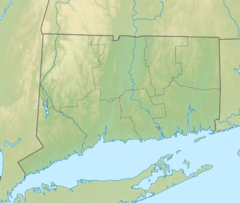East Haddam Bridge
| East Haddam Swing Bridge | |
|---|---|
 |
|
| Coordinates | 41°27′06″N 72°27′52″W / 41.45173°N 72.46432°WCoordinates: 41°27′06″N 72°27′52″W / 41.45173°N 72.46432°W |
| Carries |
|
| Crosses | Connecticut River |
| Locale | Haddam and East Haddam, Connecticut |
| Maintained by | Connecticut Department of Transportation |
| ID number | 1138 |
| Characteristics | |
| Design | Swing truss |
| Total length | 881 feet (269 m) |
| Width | 24.6 ft (7.5 m) |
| Longest span | 456 feet (139 m) 326.1 feet (99.4 m) |
| Clearance below | 24.9 ft (7.6 m) |
| History | |
| Opened | 1913 (rebuilt 1999) |
| Statistics | |
| Daily traffic | 11,600 |
The East Haddam Swing Bridge is a steel, movable (swing) truss bridge composed of two main spans crossing the Connecticut River between Haddam, Connecticut and East Haddam, Connecticut. The bridge carries Route 82, with an average daily traffic of 11,600. It is reputed to be the longest swing bridge of its kind in the world.
The pin-connected drawbridge designed by Alfred P. Boller, an authority on deep bridge foundations, was fabricated by the American Bridge Company. The bridge’s construction allowed the state to retire ferry service, which had begun in 1694, now that it had more modern means for travelers to cross the Connecticut River between East Haddam and Haddam. One of the first bridges in Connecticut paid for by the state, the East Haddam project led the legislature to form a special commission, which eventually enacted legislation that placed the control and responsibility of trunk line bridges—bridges that handled long-distance through traffic—with the State Highway Department.
On June 14, 1913, the East Haddam Swing Bridge officially opened on Flag Day. The celebration included an address by Governor Simeon E. Baldwin, a 17-gun salute, a Model-T automobile parade, and a concert that drew thousands to the event. A centennial celebration for the bridge was marked on June 15, 2013 with a local parade of antique cars.
...
Wikipedia

